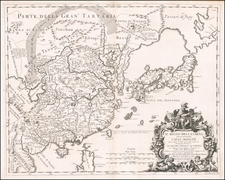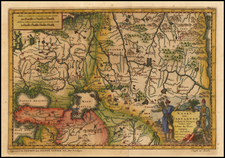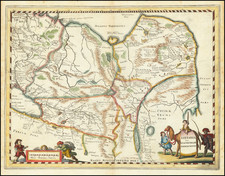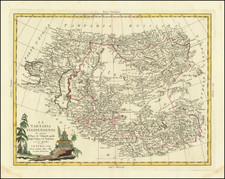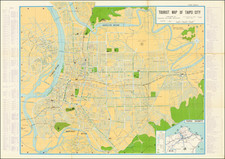Critical To The History of American Cartography
Richard Edes Harrison Maps China on the Curvature of the Earth
Fine early example of the work of Richard Edes Harrison, whose maps played a key role in "challenging cartographic perspectives and attempting to change spatial thinking on the everyday level during America’s rise to superpower status".
Edes map offers an oblique aerial view of China's varied terrain and its geopolitical situation during the early years of the Second Sino-Japanese War.
The map’s orientation and Harrison's illustrative style provide a detailed and informative geographical narrative that was pertinent to understanding the region's wartime logistics and challenges.
The map is set against the backdrop of the conflict that began on July 7, 1937, and it illustrates the resultant geographical shifts in China’s strategic focus from its vulnerable coastal plains to the more defensible interior. The juxtaposition of topographical features with the movements of people and military forces reflects the direct influence of the landscape on wartime activities and societal changes. Notably absent from the depicted terrain are volcanic features, highlighting the map's focus on the human-altered landscapes and strategic military routes.
Harrison’s depiction of internal migrations and the establishment of guerrilla warfare zones speaks to the adaptability and responses of the Chinese population and military under the pressure of invasion. The map also subtly hints at the logistical challenges faced by China in supplying its population and military, particularly through areas controlled by enemy forces.
The inset, indicating the relocation of universities, provides a nuanced layer of understanding regarding the displacement of educational and industrial foundations, essential for maintaining the continuity of Chinese culture and knowledge during wartime.
The map’s perspective from Guam implicitly connects the region’s strategic importance to the United States, aligning with the broader context of the Pacific theatre in World War II. This angle emphasizes the international implications of the conflict and the global gaze upon China's struggle.
Barnet, Timothy (2012). "Richard Edes Harrison and the Cartographic Perspective of Modern Internationalism". Rhetoric & Public History
Richard Edes Harrison was a distinguished American scientific illustrator and cartographer, widely acknowledged for his innovative data visualization and cartographic methods. Harrison was notably the house cartographer for "Fortune" magazine and served as a consultant at "Life" for nearly two decades. His contributions were pivotal in reshaping cartographic perspectives and influencing spatial thinking.
The son of biologist Ross Granville Harrison, Richard grew up in New Haven and pursued his education at Yale College. He graduated with a major in zoology and a minor in chemistry. Initially, Harrison worked as a draftsman for architect Cass Gilbert and aspired to become an architect himself. This led him to the Yale School of Fine Arts in 1926, where he studied for four years. However, the economic downturn of the Great Depression impacted the field of architecture, prompting Harrison to shift his focus to design work.
Harrison's entry into cartography in 1935 was somewhat serendipitous, stemming from a friend's request to temporarily replace a mapmaker at "Fortune." During World War II, his cartographic visualizations gained significant popularity. He advocated for a multi-perspective approach to geographic issues and critiqued conventional practices, such as the overreliance on the Mercator projection and the standard placement of north at the top of maps.
His groundbreaking work included the azimuthal projection map titled "The World Divided," first published in "Fortune" in August 1941. This map, which was extensively replicated, underscored the United States' central role in global conflict. A later version, "One World, One War," appeared in "Fortune" in March 1942 and was ordered in large quantities by the U.S. Army. Harrison’s design influenced the creation of the United Nations logo and his maps were characterized by their unique tilted perspectives.
Despite considering himself more of an artist than a cartographer, Harrison had a highly successful career in mapmaking. He was part of the staff at "Fortune" from 1936 to 1938 and worked as a map consultant at the State Department and the Office of Strategic Services, the CIA's precursor, in the 1940s and 1950s. His expertise was also sought by the Museum of Modern Art. Harrison lectured at several universities, including Clark, Syracuse, Columbia, and Trinity, and was a member of both the American Geographical Society and the Royal Geographical Society.
His contributions extended to the realm of geopolitics, where he produced maps for Nicholas Spykman's "America's Strategy in World Politics," a seminal work in 20th-century geopolitics. Harrison's legacy in cartography and data visualization remains significant, as he fundamentally challenged and transformed the way maps were perceived and used in understanding world affairs.









![[ Guangzhou / Canton ] Map of the City and Entire Suburbs of Canton. Made By Rev. D. Vrooman. 1855.](https://storage.googleapis.com/raremaps/img/small/62631.jpg)
